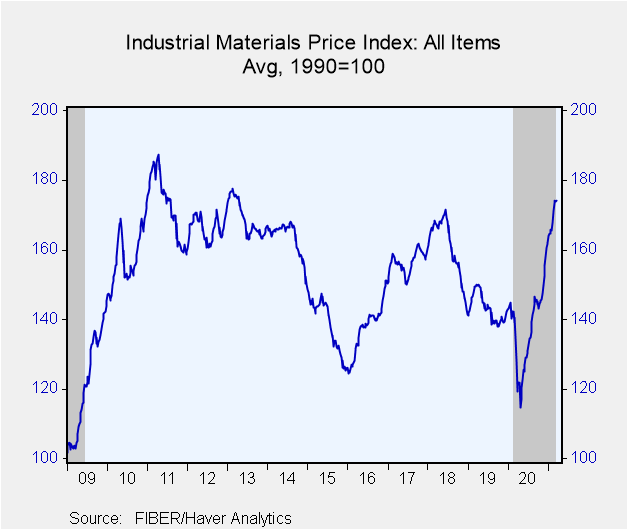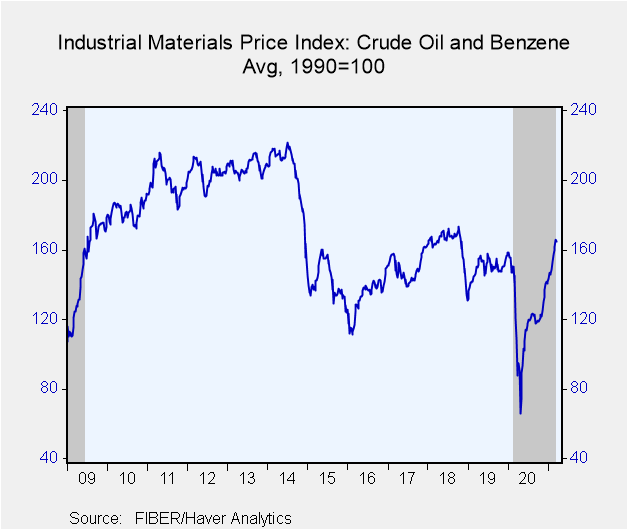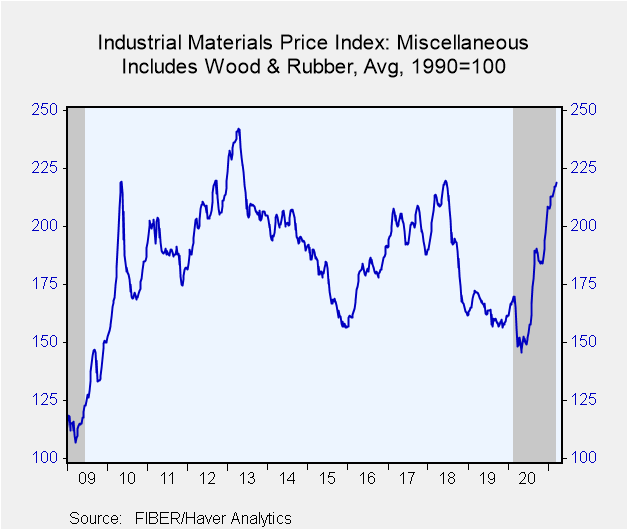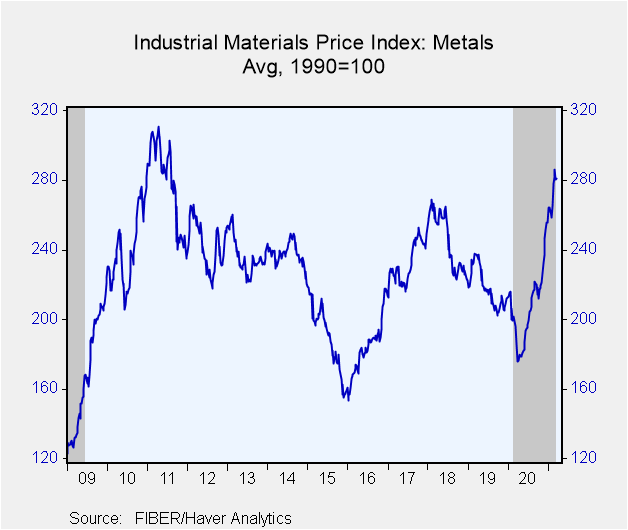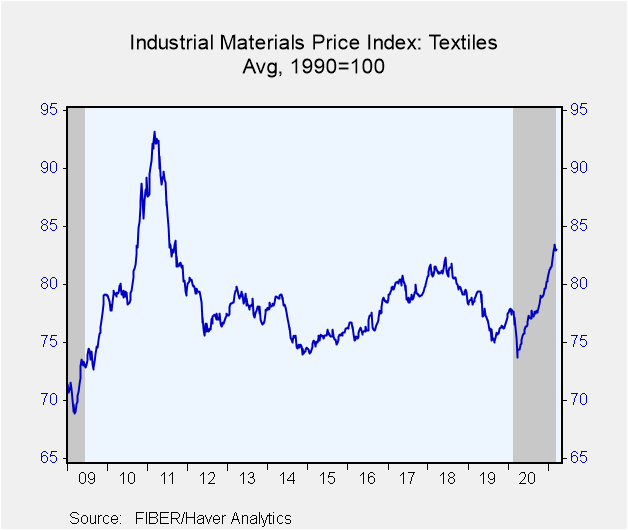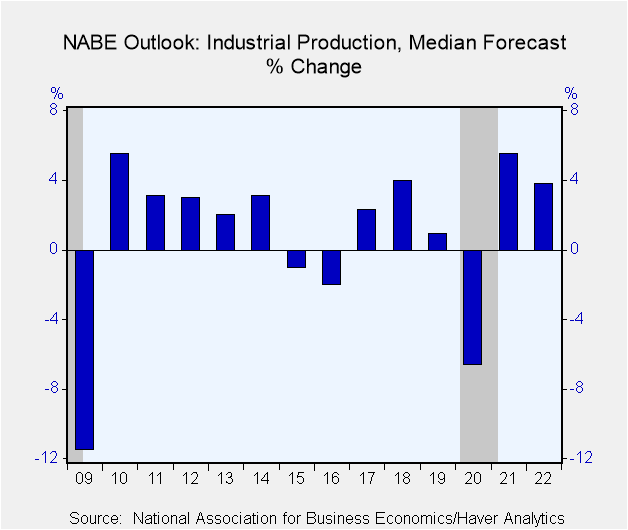 Global| Mar 19 2021
Global| Mar 19 2021FIBER: Industrial Commodity Price Rise Continues
by:Tom Moeller
|in:Economy in Brief
Summary
• Crude oil prices lead recent improvement. • Metals prices increase strongly. The Industrial Materials Price Index, from the Foundation for International Business and Economic Research (FIBER), increased 1.7% during the four weeks [...]
• Crude oil prices lead recent improvement.
• Metals prices increase strongly.
The Industrial Materials Price Index, from the Foundation for International Business and Economic Research (FIBER), increased 1.7% during the four weeks ended March 19 pulling prices up roughly one-third y/y.
Prices in the crude oil & benzene group led the recent increase with a 4.8% gain during the last four weeks. A 5.8% rise in crude oil prices to $63.95 per barrel propelled the increase. Excluding crude oil, industrial commodity prices rose 1.4% in the same period and were 31.8% higher during the last year. Prices of the petro-chemical benzene rose 14.4% during the last month and by roughly two-thirds y/y.
Prices rose 2.0% in the miscellaneous group during the last four weeks. A 3.5% surge in natural rubber prices led the increase. It was countered by a 1.8% dip in framing lumber prices which remained 216.6% higher y/y. Plywood prices have been unchanged since December 2019.
Earlier price strength in the metals group moderated as prices moved 1.0% higher during the last four weeks. The gain was led by a 6.8% rise in the price of copper scrap. Steel scrap prices gained 4.6% while aluminum prices improved 3.7%. A 0.5% easing (+46.8% y/y) in zinc prices offset these gains, while lead prices fell 8.8% during the last four weeks (+13.3% y/y).
Prices in the textile group were little changed in the last four weeks as cotton prices fell 3.2%. The cost of burlap, used for sacks, bags and gardening, improved 6.4% in the last four weeks (27.5% y/y).
Support for commodity prices should continue in the near future. Forecasts from the National Association for Business Economics call for a 5.5% rise in industrial output this year, followed by a 3.8% gain in 2022.
The Foundation for International Business and Economic Research (FIBER) develops economic measurement techniques as applied to business cycles and inflation in the U.S. and other market economies. The commodity price data can be found in Haver's DAILY, WEEKLY, USECON and CMDTY databases.
| FIBER Industrial Materials Price Index (%) | 4-Week | 3-Month | 6-Month | 12-Month | 2020 | 2019 | 2018 |
|---|---|---|---|---|---|---|---|
| All Items | 1.7 | 8.5 | 19.5 | 36.3 | 13.5 | 1.1 | -12.0 |
| Excluding Crude Oil | 1.4 | 7.1 | 17.2 | 31.8 | 16.0 | -0.6 | -11.1 |
| Textiles | 0.1 | 3.5 | 6.7 | 10.2 | 3.9 | -1.6 | -2.8 |
| Cotton (cents per pound) | -3.2 | 15.3 | 37.0 | 55.9 | 11.6 | -6.6 | -9.2 |
| Metals | 1.0 | 9.9 | 27.7 | 51.3 | 20.4 | -4.3 | -12.2 |
| Aluminum ($ per metric ton) | 3.7 | 7.4 | 24.3 | 33.6 | 13.1 | -6.5 | -12.7 |
| Copper Scrap (cents per pound) | 6.8 | 16.2 | 33.6 | 75.3 | 26.9 | 3.5 | -16.1 |
| Steel Scrap ($ per ton) | 4.6 | 7.5 | 47.1 | 64.5 | 43.6 | -0.8 | 2.3 |
| Crude Oil & Benzene | 4.8 | 16.0 | 39.2 | 51.6 | -9.7 | 20.2 | -20.0 |
| Crude Oil (WTI, $ per Barrel) | 5.8 | 34.7 | 64.6 | 133.8 | -21.4 | 35.5 | -24.4 |
| Miscellaneous | 2.0 | 8.0 | 14.8 | 40.1 | 29.1 | -0.0 | -14.8 |
| Framing Lumber ($ per 1000 board ft.) | -1.8 | 21.6 | 8.1 | 216.6 | 113.5 | 22.6 | -23.1 |
| Natural Rubber (cents per pound) | 3.5 | 2.3 | 22.9 | 53.7 | 48.6 | 10.7 | -4.1 |
Tom Moeller
AuthorMore in Author Profile »Prior to joining Haver Analytics in 2000, Mr. Moeller worked as the Economist at Chancellor Capital Management from 1985 to 1999. There, he developed comprehensive economic forecasts and interpreted economic data for equity and fixed income portfolio managers. Also at Chancellor, Mr. Moeller worked as an equity analyst and was responsible for researching and rating companies in the economically sensitive automobile and housing industries for investment in Chancellor’s equity portfolio. Prior to joining Chancellor, Mr. Moeller was an Economist at Citibank from 1979 to 1984. He also analyzed pricing behavior in the metals industry for the Council on Wage and Price Stability in Washington, D.C. In 1999, Mr. Moeller received the award for most accurate forecast from the Forecasters' Club of New York. From 1990 to 1992 he was President of the New York Association for Business Economists. Mr. Moeller earned an M.B.A. in Finance from Fordham University, where he graduated in 1987. He holds a Bachelor of Arts in Economics from George Washington University.


